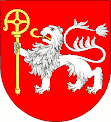Klášter Hradiště nad Jizerou
| Klášter Hradiště nad Jizerou | ||||
|---|---|---|---|---|
|
||||
| Basic data | ||||
| State : |
|
|||
| Region : | Středočeský kraj | |||
| District : | Mladá Boleslav | |||
| Area : | 462 ha | |||
| Geographic location : | 50 ° 32 ' N , 14 ° 57' E | |||
| Height: | 228 m nm | |||
| Residents : | 991 (Jan 1, 2019) | |||
| Postal code : | 294 15 | |||
| structure | ||||
| Status: | local community | |||
| Districts: | 1 | |||
| administration | ||||
| Mayor : | Jiří Navrátil (as of 2006) | |||
| Address: | Klášter Hradiště nad Jizerou 2 29415 Klášter Hradiště n.Jiz. |
|||
| Municipality number: | 536024 | |||
| Website : | www.mesta.obce.cz/klaster-hradiste | |||
Klášter Hradiště nad Jizerou (German monastery on the Jizera ) is a municipality in Okres Mladá Boleslav , Czech Republic . The place borders directly on the town of Mnichovo Hradiště , on the western edge of the Český ráj nature reserve . A strong monastery beer is brewed in the village. On the grounds of the brewery are the remains of the Cistercian -Ordenshauses monastery Hradiště dating from the 12th century.
history
Early medieval settlement
At the top of the rock above the confluence of the Jizera and Zábrdka rivers , there was very likely an early medieval Slavic castle. This is indicated by the place name Hradiště (castle site). Settlement from the 8th to 9th centuries is documented by several body graves discovered in 1934, which contained S-shaped bronze earrings. A fortification could not yet be proven archaeologically.
Cistercian monastery
In the second half of the 12th century, the Cistercians from Plasy founded a subsidiary in Hradiště . The years 1145 and 1177 are considered possible dates of origin. Whether the monastery was originally a Benedictine abbey is disputed. In 1351 the place is called gredis monachorum for the first time . The Czech translation Mnichovo Hradiště was later transferred to the neighboring town.
The property grew in the High Middle Ages mainly through the promotion of inland colonization . From the 13th century a number of settlements emerged in the area, the founding of which is attributed to the influence of the monastery. At the beginning of the 15th century, Klášter Hradiště had grown into one of the most powerful manors in north-east Bohemia. In a written around 1400 Urbarium 112 villages and farms are recorded which belonged to the monastery. The beginning of the 15th century marked the climax of the monastery's economic power, at the same time the morality of the order declined. The monks tried to persuade the population to donate by simulating miraculous signs. 1404–1405 a complaint was received by the Archbishop of Prague. The investigative commission also included the Bohemian reformer Jan Hus , who in his report condemned the fraudulent machinations of the monks of Hradiště.
After the Hussite Wars
At the beginning of the Hussite Wars , the monastery was captured and burned down by the Orebites on April 30, 1420 . The monks fled to the Bezděz castle . The rock monastery was never rebuilt, the property split up and resold several times. From Václav Budovec z Budova , who was executed after the class uprising in Bohemia in 1621, the remaining rule came to the general Albrecht von Wallenstein and from there to the Waldstein family , who lived in the neighboring castle until 1945 .
Jiří von Labouň had a Renaissance chateau built on the ruins of the monastery in the middle of the 16th century . It served as the administrative center of the extensive Waldstein property and until 1850 also as the seat of the public authorities for the municipality of Klášter and 10 surrounding smaller judicial districts. In 1869 the old castle fell victim to a fire and the local brewery, attested since 1570, moved to the castle grounds. The company is still located here today.
Since the 17th and 18th centuries German settlers moved into the area devastated by the Thirty Years' War, Klášter Hradiště has been on the German-Czech language border. A German school was set up in the village for the children of Waldstein officials, but the population remained Czech in contrast to the neighboring communities. The parish was redistributed in 1864 and 1920. Today 729 people still live in the village (as of 2006).
Attractions
- The construction of the Cistercian monastery began in the 12th century in the Romanesque style and continued until around 1260 in the early Gothic style . The largest building in the monastery, the cathedral, was originally 75 meters long, 40 meters wide and 15 meters high in the central nave. After the destruction in 1420, during the construction of the castle in the 16th century and the castle fire in 1869, all that remained on the site of today's brewery was an early Gothic portal and some remains of the surrounding walls.
- Parish Church of the Virgin Mary
literature
- Jaromír Jermář: History of Kláštera Hradiště nad Jizerou . In: 850 let Kláštera Hradiště nad Jizerou . Published by the local government, 1994.
Web links
- Website (CZ)
Individual evidence
- ↑ Český statistický úřad - The population of the Czech municipalities as of January 1, 2019 (PDF; 7.4 MiB)




